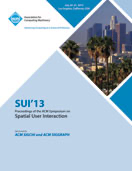
1st Symposium on Spatial User Interaction 2013 Proceedings
Wolfgang Stuerzlinger, Frank Steinicke
Abstract:
It is our great pleasure to welcome you to the first ACM Symposium on Spatial User Interaction - SUI'13. This new event focuses on the user interface challenges that appear when users interact in the space where the flat, twodimensional, digital world meets the volumetric, physical, three-dimensional (3D) space we live in. This considers both spatial input as well as output, with an emphasis on the issues around the interaction between humans and systems. The goal of the symposium is to provide an intensive exchange between academic and industrial researchers working in the area of SUI and to foster discussions among participants. The first SUI symposium was held July 20-21, 2013 in Los Angeles, USA.
The call for papers attracted 31 submissions from Asia, Europe, Australia, and North and South America in all areas of Spatial User Interaction research. The international program committee consisting of 15 experts in the topic areas and the two program chairs handled the highly competitive and selective review process. Every submission received at least four detailed reviews, two from members of the international program committee and two or more from external reviewers. The reviewing process was double-blind, where only the program chairs as well as the program committee member, who was assigned to each paper to identify external reviewers, knew the identity of the authors.
In the end, the program committee accepted overall 12 (8 full papers plus 4 short papers) out of 31 submissions, which corresponds to an acceptance rate of 26% for full papers (and 38% in total). Additionally 12 posters and demonstrations will complement the program and appear in the proceedings. The topics range from spatial interaction techniques, vision in 3D space, applications, to interaction with multi-touch technologies and in augmented reality. We hope that these proceedings will serve as a valuable reference for Spatial User Interaction researchers and developers.
Putting together the content for SUI'13 was a team effort. We first thank the authors for providing the content of the program. Special thanks go to the members of the international program committee, who successfully dealt with the reviewing load. We also thank the external reviewers.
